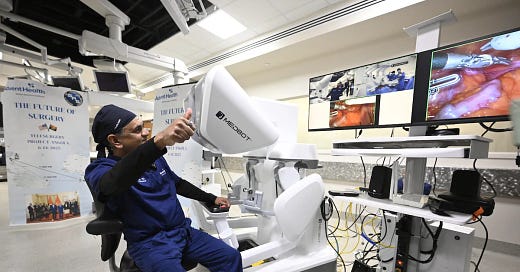Record set on remote robotic prostatectomy—Florida to Angola, Africa. 'Health equity breakthrough?' Or just another notch for tech? Let's get real.
Virtual reality and harsh realities of rehab plus more on former President Biden
(Dr. Vip Patel in the Sunshine State gives a thumb’s up to his colleagues in ‘The Land of the Giant Sable,’ Angola, Africa—nearly 7k miles away.)
By Howard Wolinsky
On June 14, famed prostate cancer surgeon Vip Patel set a new record in remote transcontinental surgery.
He performed a robotic prostatectomy from his base in Celebration, Florida on a patient in Luanda, the capital of Angola on the East Coast of Africa. That’s an eyelash under 7,000 miles.
Patel, medical director of the Global Robotics Institute at AdventHealth Celebration, and Amanda Maggard, CEO of AdventHealth Celebration, were positively giddy, not only about the remarkable technological achievement but also their visions of this remote robotic prostate surgery being a solution to inequities in healthcare globally.
I buy the tech story, but I am skeptical about how much of an humanitarian impact this sleek technology will have while we face cuts in the U.S. Medicaid program for indigents and possibly in Medicare.
First, let’s hear the brags.
“This moment reflects the heart of our mission,” said Maggard. “We are proud to support Dr. Patel and our Global Robotics Institute team in pushing the boundaries of what’s possible in medicine — and doing so with compassion and purpose.”
“This first-of-its-kind FDA-approved clinical trial for U.S.-based transcontinental robotic telesurgery is a stunning breakthrough — not just technologically, but in advancing global health equity,” said Patel, a top-gun urologic surgeon who has performed nearly 20,000 prostatectomies using robotic technology. “It marks a critical step toward delivering high-quality surgical care to remote, rural and underserved communities that have long lacked access. This is more than innovation — it’s a humanitarian leap forward.” (All emphases added.)
The hospital news release notes: “Angola faces one of the highest prostate cancer mortality rates in sub-Saharan Africa, with limited access to early detection and specialized surgical care, according to the Global Cancer Observatory (GLOBOCAN). This telesurgery represents a critical step in addressing those disparities and bringing life-saving treatment to underserved populations.”
Patel noted that most of the world's population does not have access to experienced medical teams, but he believes robotic telesurgery has the potential to solve a massive, global healthcare problem.
It all sounds so noble. But let’s get real. Is robotic surgery for the masses a pipe dream, named for the fantasies experienced by opium smokers? What are they smoking in Celebration?
It sounds a bit like Marie Antoinette, the last queen of France, who supposed said of the hungry peasants: “No bread? Let them eat cake.”
Don’t patients in poor African countries, where prostate cancer is rampant and incomes are low, already have problems getting access to relatively cheap PSA screening let alone expensive robotic surgery? Could putting food on the table be a greater priority?
Costs for robotic prostatectomies vary around the world as they do within this country. They cost from $15,000 to $35,000 in the U.S. compared with $12,000 to $24,000 in Europe and a more reasonable $8,500 in South Africa, a bit closer to Angola.
“Due to its political and financial situation, Angola is considered one of the least developed countries in the world. With an average annual income of 2,120 USD, it is one of the lower middle-income countries,” according to WorldData.
Healthcare in Angola makes the U.S. system—the worst of the rich countries look like the model of efficiency. We spend more per capita than the other wealthy nations and get the poorest outcomes.
Theoretically, primary healthcare in Angola is free, but there is limited access to quality care and the country’s infrastructure is inadequate and there are staffing shortages to boot.
Who did Patel operate on? A wealthy Angolan? Or a patient from a rural area?
Going forward, realistically, I wonder how many of these expensive transcontinental robotic surgeries Patel and other urologists will perform on “humanitarian” grounds in low-income countries. I am curious, too, about how many charity robotic surgeries he performs now on poor Floridians in his backyard.
So, in the end, was the real goal to overcome inequities in healthcare or to get bragging rights about new surgical distance records?
Should the emphasis be on the distribution of expensive healthcare? Or to find ways to efficiently manage the coming prostate cancer “tsunami”?
What do you think?
In May, Prostate Cores reported on the first transcontinental remote probot-assisted high-intensity focused ultrasound (HIFU) focal therapy procedure for prostate cancer on a patient at Cleveland Clinic Abu Dhabi. That’s just over 7,000 miles between doctor and patient. Technically, I don’t think this is considered surgery. Residents of Abu Dhabi are required to have health insurance and the quality of care there and throughout UAE is considered high. So this may be feasible though there must be more efficient ways.
Virtual reality to overcome harsh realities of rehabfor PCa patients in remote areas in the Western U.S.
By Howard Wolinsky
By Howard Wolinsky
We hear a lot about how AI (Artificial Intelligence) is impacting prostate cancer.
But how about another buzzword: virtual reality?
Huntsman Cancer Institute at the University of Utah that is exploring how virtual reality can be used as a form of rehabilitation services for people who have been diagnosed with metastatic prostate cancer.
Wearing VR headsets, patients see a virtual racetrack where their race car moves with a speed based on their real-life cycling speed on a portable bike. Patients are given a prescribed exercise routine displayed on a virtual dashboard with metrics to hit during their exercise session.
In a study published in Studies in Health Technology and Informatics. Utah researchers found that even though most patients had never used VR previously, engaging visuals and the gamified activity enhanced their motivation while exercising. The study involved patients with metastatic prostate cancer ) undergoing androgen deprivation therapy (ADT).
“The VR device helps patients focus on their exercise prescription and makes their exercise plan more enjoyable,” Manish Kohli, MD, a specialist in prostate cancer research.
(Dr. Manish Kohli)
Virtual reality helps overcome the long distances in the West that make it difficult for patients, especially the elderly, to get to major medical medical centers. In-person rehabilitation services are scarce in rural and frontier areas. By serving the five-state Mountain West, including Utah, Idaho, Montana, Nevada, and Wyoming, Huntsman Cancer Institute provides care to the largest geographic region of any National Cancer Institute-designated Comprehensive Cancer Center. This means that patients often travel large distances to access care.
“Distance can be a significant barrier to accessing rehabilitation services. Traveling to rehabilitation centers can be impractical or even impossible for many patients.” Kohli said. “For those living in remote or rural areas far from Salt Lake City, traveling such long distances for rehabilitation—particularly on a daily basis—can quickly become exhausting and discouraging. The time, effort, and logistical burden of a round trip to the hospital often lead patients to give up after just a few days.”
Researchers wrote: “Some participants encountered challenges, including difficulty using the headset with glasses, initial confusion with technical terms, and concerns about cost and equipment durability. While most appreciated the system's flexibility for home-based rehabilitation, one participant preferred traditional, non-technological exercises. These findings suggest that VR can effectively address barriers in conventional cancer rehabilitation programs, but improvements in user support and cost considerations are necessary for wider acceptance. Further research should focus on the long-term effects of VR on patient outcomes.”
Please answer a survey on genetic testing and PCa
At the end of July, I will be moderating a program for ASPI on the importance of genetic testing for prostate cancer patients. Can you respond to this survey: https://forms.gle/Uv9d5gaZYHadZ5Qh9—Howard Wolinsky
Sparing nerves and erections at last?
By Howard Wolinsky
Back in the 1990s, many surgeons promised they “spared nerves” during radical prostatectomies to save the men’s erectile function. It didn’t always turn out that way.
Now British researchers are claiming in the NeuroSAFE PROOF trial, presented at the 2025 European Association of Urology (EAU) Congress in Madrid and published in The Lancet Oncology.
The trial evaluated NeuroSAFE), a method of preserving the nerves that run through the prostate’s outer layers thought to be responsible for producing erections, during prostate removal using robot-assisted radical prostatectomy (RARP). The pioneering method includes an additional test to ensure that all of the cancerous cells are removed, so that preserving the nerves does not risk the surgery’s success.
Nearly twice as many men who underwent NeuroSafe preserved their erectile function compared to those undergoing standard RARP.
Senior researcher Dr. Greg Shaw, of University College London Hospitals NHS Foundation Trust,explained, “By using NeuroSAFE, nearly twice as many men don’t have to face potentially life-changing loss of erectile function after prostate surgery.” He stressed that while the procedure requires expertise, it is not costly and does not compromise cancer control.
Serious adverse events occurred in six (3%) of 190 patients in the NeuroSAFE group, and and in five (3%) of 191 patients in the standard RARP group. All adverse events were postoperative complications; no serious adverse events or deaths were attributed to the study intervention.
NCCN offers help with newly digitized guidelines for PCa
The National Cancer Comprehensive Network has launched its new NCCN Guidelines Navigator, digitized version of its widely used guidelines. The first draft focuses on prostate cancer, the most common cancer in AMerican men. Other digitized guidelines will follow soon for colon and rectal cancers.
The idea is to simplify searches and navigation of NCCN guidelines, which are used by 90% of cancer experts.
You can access the Navigator by creating a free NCCN account or logging into your existing account: NCCN.org/login
NCCN says the new Navigator helps users:
Move seamlessly through the Guideline using the table of contents or search features
Select answers in nodes to highlight relevant Guidelines pathways
Improve navigation. Sections of the Guidelines are color-coded and linked, allowing users to directly navigate to that section
Select the Clear button to reset and clear any selected answers
Easily view related footnotes
Type prompts which the search function will auto-complete and select filters to highlight content of interest
Access the related NCCN Chemotherapy Order Templates (NCCN Templates®) via the ID number. NCCN Templates® can only be accessed by subscribed users.
Zoom out to see the whole algorithm
View a tutorial and FAQ when needed
Here’s a direct link to all of the versions of the clinical guidelines for prostate cancer, including the new NCCN Guidelines Navigator version: https://www.nccn.org/guidelines/guidelines-detail?category=1&id=1459.
Separately, there are also the NCCN Guidelines for Patients – which put the same information into more lay friendly terms. The prostate cancer guidelines are separated into two books: Prostate Cancer: Early Stage and Prostate Cancer: Advanced Stage.
These are also free – and no registration required to access.Cracking the code on pathology reports: Helping patients navigate medicalese and getting better care
By Howard Wolinsky
The next webinar from Active Surveillance Patients International will be touching on how many patients don’t understand pathology reports or even Gleason scores—and what can be done about it,
So come, please, and maybe share your experience with pathology reports and medicalese.
Cathryn J. Lapedis, MD, MPH, a Clinical Assistant Professor of Pathology at Michigan Medicine in Ann Arbor, has found in her research that patient-centered reports can help patients understand the reports.
She will be the featured speaker at the ASPI webinar from noon to 1:30 p.m. on Saturday, June 28.
Please register for the meeting here.
Lapedis was the lead author of a recent study in JAMA that found a 93% comprehension of patient-centered pathology reports compared with 39% of those who read a report from the University of Michigan and 56% reading a pathology report from the Veterans Administration.
While 93% of participants who received the PCPR accurately identified that the report showed prostate cancer, only 39% of those who received the university report and 56% of those who received the VA report did so.
She also looked at how these patients interpreted Gleason scores: 84% reading specially prepared patient-centric reports understood their scores vs 48% for the university group and 40% for the VA group.
She has fellowship training in medical renal and gastrointestinal pathology. Her research centers on rethinking the way pathology results are communicated to patients and the healthcare system. She completed an in-depth analysis of key stakeholders’ attitudes towards patient-pathologist interactions, and is currently piloting early interventions in patient-centered pathology communications.
Please send questions in advance to: contactus@aspatients.org
Rundown on treatment options following the case of former President Biden
The diagnosis of Gleason 9 prostate cancer in former President Joe Biden has shined a spotlight on advanced prostate cancer care. The University of Colorado presents a rundown on detecting and treating men above 70 here. Testing for prostate cancer can be fraught, particularly among men older than age 70, and sometimes it can go from undetectable to metastatic — spreading to bone, as in Biden’s case, or to lymph nodes — in a matter of months.
“Something like President Biden’s presentation is a little surprising. However, for somewhere around 5% of men, when they start their workup for prostate cancer, we find that they’re already metastatic. It’s called a de-novo metastatic presentation,” said Dr. David Strauss, a University of Colorado School of Medicine urologic oncologist.
(Dr. David Strauss)
The release describes the varying guidelines for older men. These guidelines are for men who have not previously been diagnosed.
A major gap: There are no screening guidelines for men 75 and above who have already been diagnosed with low-risk prostate cancer. Check out my story on this.
Older men and advanced prostate cancer
In an interview in Urology Times, Stacy Loeb, MD, a urologic oncologist at NYU Grossman School of Medicine and Perlmutter Cancer Center in New York, highlighted prostate cancer issues especially in older men with advanced prostate cancer.
She stressed, “All patients with high-grade cancer require a staging evaluation, including imaging, to determine whether the cancer has spread” she said.
Loeb noted that early-state cancers more typically have no symptoms. [Check my article in Undark.] In contrast, she said, President Biden's increased urinary symptoms led to his getting medical attention.
She emphasized the importance of prostate-specific membrane antigen (PSMA) PET scans and bone scans in initial diagnosis and staging. to determine whether the cancer is localized or has spread.











